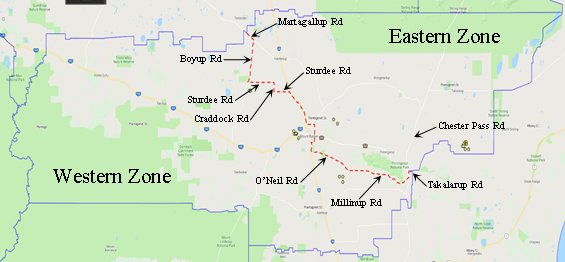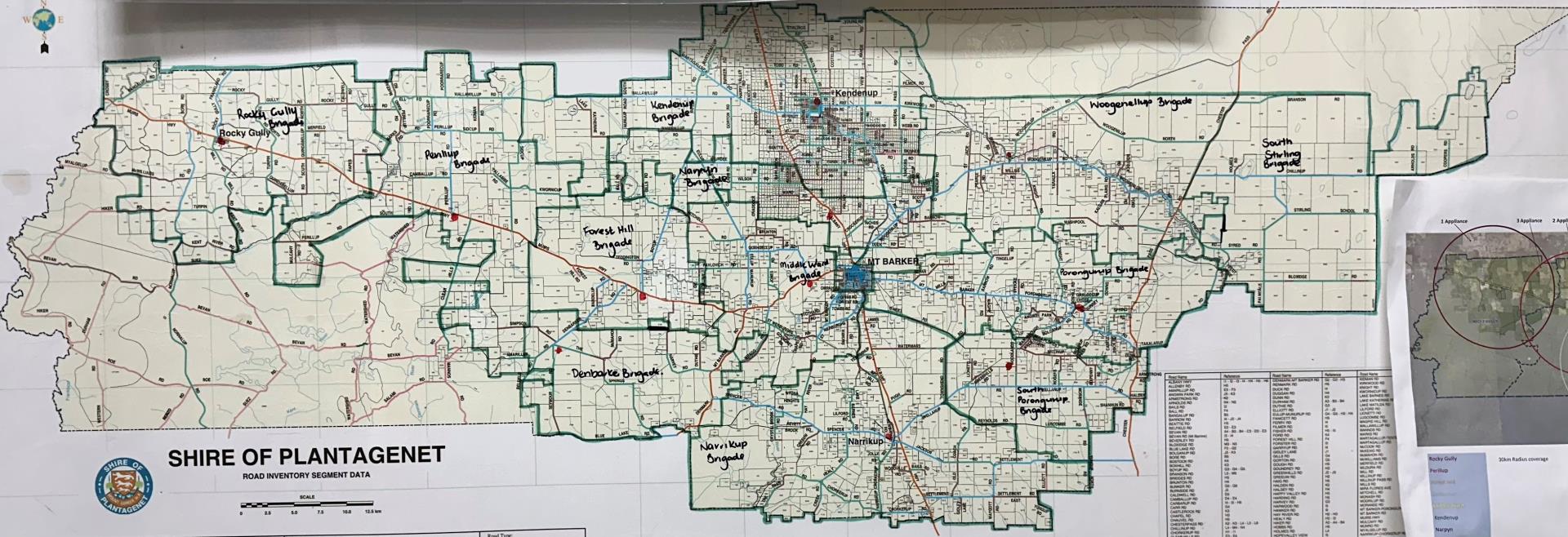As of 15 December, all zones are in Prohibited Burning Time - this means strictly no fires or open flames. Camping and cooking fires are prohibited from 3 October until 30 April.
Lighting fires on your property can be extremely dangerous. To reduce the risk, PROHIBITED and RESTRICTED burning times are set. These dates indicate when you are required to seek a Burning Permit (Restricted Burning Time) and when lighting of fires is prohibited.
These dates may vary due to seasonal conditions. For current information, please phone 9892 1111.
| Zone |
Restricted Burning Times |
Prohibited Burning times |
| Eastern Zone |
1 March to 30 April (permits required)
|
15 November to 28 February and Good Friday
|
| Western Zone |
1 March to 30 April (permits required)
|
15 December to 28 February and Good Friday |

The Shire produces an Annual Bush Fire Mitigation Notice which outlines your responsibilities. This is sent to all properties with the rates notice and copies are given to real estate agents to deliver to rentals. The Notice is a legally enforceable document. If you don’t comply with your requirements you could be fined or have legal action taken against you.
Please take time to read and understand the Annual Bush Fire Mitigation Notice. For any clarification, please contact the Shire on 9892 1111.
Emergency contacts
To report a fire or life threatening emergency please call 000. For Harvest and Vehicle Movement Ban (HVMB) information call 9892 1102.
| Ambulance: |
000 |
| Hospital: |
9892 1222 |
| Doctor: |
9892 1000 |
| Police: |
9851 1122 |
| SES |
132 500 |
| Town Fire & Rescue: |
000 |
To be notified of an impending fire download Bushfire.io to register your address and choose the distance at which you are alerted.
Bushfire prevention and control
Bushfires are an inevitable part of life in rural areas. Bushfires can happen at any time during the year especially during spring, summer and early autumn and can put properties and lives in danger. The only way to protect you and your property is through early preparation.
Asset Protection Zones
All Shire of Plantagenet landowners and occupiers must prepare their property for the bush fire season.
This includes homeowners, tenants, absentee landowners, holiday homeowners and people living on rural properties. Properties are checked for compliance at certain times of the year, based on the zone (Eastern or Western) they are in.
All properties require an Asset Protection Zone (APZ). An APZ is an area surrounding a building that is managed to reduce the bushfire hazard to an acceptable level. These requirements are outlined in the Annual Bush Fire Mitigation Notice. The Shire has a list of Fire Mitigation Contractors that can help get your property ready for compliance.
The Shire also carries out a Bushfire Mitigation Program through the Mitigation Activity Fund (MAF). This State Government funding supports local governments in managing high-risk areas.
Total Fire Bans
Total Fire Bans (TFB) are imposed by the Department of Fire and Emergency Services (DFES). A TFB prohibits any activity likely to cause a fire but does not include agricultural activities. To find out if a Total Fire Ban is in place or for more information call the DFES Total Fire Ban Information Line on 1800 709 355 or visit the DFES website.
Harvest and Vehicle Movement Bans
On days of high bush fire threat, the Shire may impose a Harvest and Vehicle Movement Ban (HVMB). If a HVMB is imposed, you cannot conduct any harvesting activity or operate any internal combustion engine unless on a formed road or the driveway to your property.
To find out if a HVMB is in place call 9892 1102 for a recorded message or subscribe to a free SMS service by calling 9892 1111 during business hours.
Protecting your property and business
Property owners are encouraged to have a fully functional fire fighting unit available during bushfire season (October to April).
Got 15 Minutes to Burn?
The Department of Fire and Emergency Services' (DFES) bush fire safety campaign Got 15 Minutes to Burn? encourages all Western Australians to make a bush fire plan. It's as simple as going to the My Bushfire Plan website or mobile app to develop an easily accessible plan that outlines what you and your family, including pets and other animals, will do if a bush fire occurs.
What to do if a bush fire threatens your property
During a bush fire, stay up to date with the latest alerts and warnings at emergency.wa.gov.au, 13 DFES (13 3337), facebook.com/dfeswa or your local ABC Radio.
The safest place to be if a bushfire threatens is as far away from the fire as possible, but this only applies if you leave early. Traveling on smoke covered roads is very dangerous and could put you in worse danger so if you can’t leave early, it’s best to shelter in your home. This is where the preparation you undertook in the cooler months really pays off.
Pets and stock
Include pets in your bushfire plan but remember that evacuation centres cannot cater for a large number of pets. It is best if you can prepare your home and property so that pets and stock have a safe place of refuge, such as a cleared area or an eaten out portion of the paddock with a simple shelter. It is important to remember to never cut fences, it will only put stock in more danger and could inadvertently cause car accidents. Create a Plan for Animal Welfare in Emergencies (PAWE) for horses or pets.
Bushfire organisations
There are 11 bushfire brigades across the Shire, and they have some of the most technically advanced bush fire fighting appliances in WA. They are staffed by volunteers and if you are new to the area, it’s a good idea to meet the brigade so they know who and where you are.

The community relies on the dedication and commitment of volunteers for all of its emergency services. Not only is volunteering with an emergency service an avenue to learn new skills and challenge yourself, it is a great way to meet people. For more information, see the following links:
DFES
State Emergency Service
St John Ambulance
Volunteer Fire and Rescue Services WA
Fire Control Officers
Each brigade has Fire Control Officers (FCOs) who are empowered under the Bush Fires Act 1954. A FCO has the power to enter a property to inspect fire prevention and hazard reduction activities, instruct a property owner to conduct hazard reduction activities and issue permits to burn during the Restricted Burning Period.
This document lists all Fire Control Officers and contact information.
Bush Fire Advisory Committee
The Shire supports a Bush Fire Advisory Committee which meets half-yearly to discuss all fire related matters. The Committee is made up of delegates from each bush fire brigade, the Chief Bush Fire Control Officer and an executive team.
Local Emergency Management Committee
The Shire also supports a Local Emergency Management Committee which meets quarterly to discuss emergency management and preparedness. The Committee is made up of representatives of all emergency services, Shire staff and support agencies such as Western Power and Main Roads.
Local Emergency Management Arrangements (LEMA) are produced and issued under the authority of S. 41(1) of the Emergency Management Act 2005, endorsed by the Shire of Plantagenet Local Emergency Management Committee and the Council of the Shire of Plantagenet. The Arrangements have been tabled for noting with the Great Southern District Emergency Management Committee and State Emergency Management Committee.
Please contact the Shire's Community Emergency Services Manager (CESM) on 9892 1111 for up to date contact information and other documents not included here.
Bushfire warning systems
During a bush fire, DFES and the Department of Parks and Wildlife issue community alerts and warnings for fires that threaten lives and property. Understanding the Bushfire Warning System is extremely important in helping you and your family to stay alert and informed when a bushfire starts.
The system uses the following alerts:
Advice: A fire has started but there is no immediate danger. Stay alert and watch for signs of a fire. Be aware and keep up to date.
Watch and Act: A fire is approaching and there is a possible threat to lives or homes. You must start to act. If your plan is to leave, make sure you leave early. If your plan is to stay, check all your equipment is ready. Only stay and defend if you are mentally and physically prepared.
Emergency Warning: An out-of-control fire is approaching fast and you need to take immediate action to survive. If you haven't prepared your home it is too late. You must leave now if it is safe to do so, or seek shelter.
All Clear: Bushfires that start in these conditions are unlikely to spread in a dangerous or life-threatening way, but you still need to remain alert and abide by local seasonal laws and regulations.
These levels change to reflect the increasing risk to your life or property and decreasing amount of time before the fire arrives. For more information:
Bushfire mitigation for plantations and tree farms
These are defined as areas exceeding 3 hectares within townsites, or 10 hectares in rural areas, of trees planted or land under preparation for planting of trees for commercial purposes. Firebreaks must be constructed on all boundaries, or other locations as agreed to by Council.
Firebreaks
- 15 metres wide and free of flammable material, with a trafficable surface of at least 6 metres, and vertical clearance to a height of 4 metres above ground level over the trafficable portion of the firebreak.
- Planting compartments consisting of an area of approximately 30 hectares must be surrounded by 6 metre wide firebreaks cleared of all flammable material (with a 5 metre trafficable surface). A vertical clearance of all overhanging branches, at least 4 metres above ground level is required. This applies to all established and subsequent rotation (coppice) plantations.
- Planting compartments for new or re-established plantations after 1 July 2012 must consist of an individual area of approximately 30 hectares surrounded by firebreaks with an 8 metre tree to tree separation, a 6 metre horizontal clearance free of all flammable material (with a 6 metre trafficable surface) and a vertical clearance of all overhanging branches to at least 4 metres above ground.
All landowners or managers of plantation estates greater than 10,000 hectares in total require a 3.4 Heavy Duty Appliance (4x4 truck carrying 3,000 litres of water) located within the Shire.
During harvest a 400 litre (minimum) mobile fire fighting unit must be kept in or adjacent to area being harvested.
All areas of the property which are not a plantation or tree farm must comply with relevant requirements detailed in the Bushfire Mitigation Notice.
Harvested and reversion plantations
Plantation firebreaks must remain in place until all stumps are removed. Boundary firebreaks are to be 6 metres wide (with a 5 metre trafficable surface) and a vertical clearance of all overhanging branches at least 4 metres above ground level. All compartment firebreaks to be maintained to the same measurements.
Abandoned plantations
Plantation firebreaks must remain in place until all stumps are removed.
Fire protection of private plantations
All plantations must comply with the Guidelines for Plantation Fire Protection unless approval to vary those conditions has been granted by the Shire.